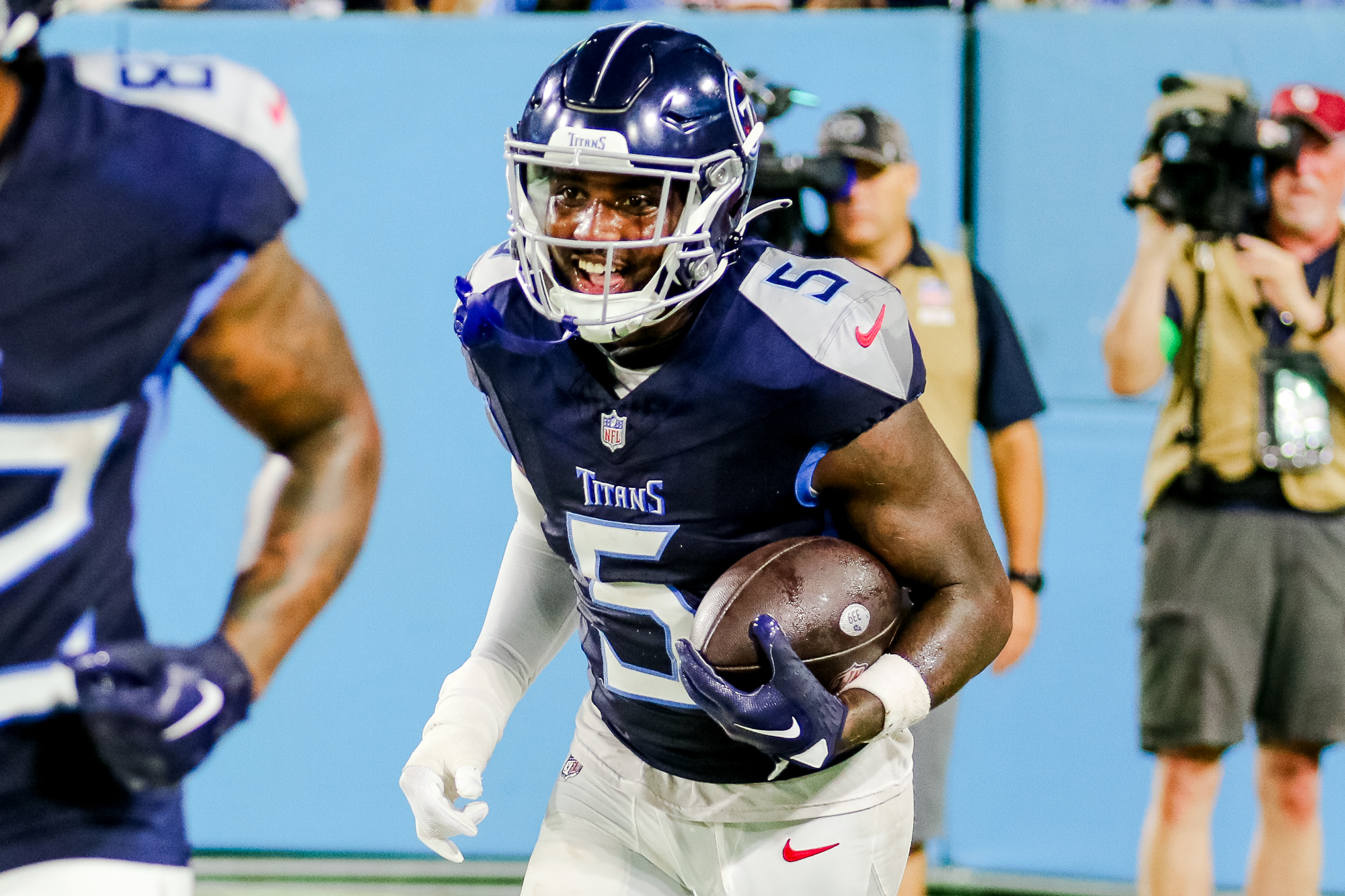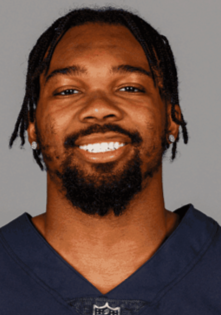By MIKE HERNDON, columnist
NASHVILLE, Tenn. -- The 2023 Tennessee Titans officially cut down from 90 to 53 players along with the rest of the NFL on Tuesday. I want to hit on a couple of overarching thoughts before we drill down into the roster and discuss some of the biggest decisions that Mike Vrabel and Ran Carthon made at each position.
First, the team kept 11 rookies on the initial 53-man roster. That’s just over 20 percent of the roster made up of first-year players. It’s not quite as high as the Bucs (13) or Rams (14), but it’s certainly towards the top of the league in that category.

That 11 included all six draft picks along with five undrafted players. That speaks to the lack of depth that we’ve talked about all offseason. Yes, some of these undrafted players made an impact in camp and preseason to earn a roster spot, but there was also plenty of opportunity available at the back of this roster for Kearis Jackson, Caleb Murphy, Otis Reese, Anthony Kendall, and Matthew Jackson to win a job.
Last season, only the Bears – who would go on to finish with the league’s worst record – started the season with five or more undrafted
rookies. They had six. That’s not to say that the Titans are going to be nearly as bad as the 2022 Bears, but the depth concerns are real and this is clear evidence to back it up.
However, I think this team is getting younger, and that’s generally a good thing after ranking among the league’s oldest teams in recent years. Among the 53 players on the initial roster, 30 were 25 years old or younger. That’s up from 24 a year ago.
One more quick point that I think gets somewhat lost in the rush of roster cut-down day news… I think the distinction between the 53-man roster and the practice squad is much larger to players and fans than it is to the team itself. For players, the difference represents a huge gap in pay. Practice squad members with less than two years of accrued seasons make $12,000 per week. However, a week on the 53-man roster pays a minimum of $41,667. It’s great money either way but being on the roster more than triples your income compared to the practice squad.
With the practice squad elevation rules that are now in place (up to two squad players can be activated for game day each week), teams are able to use players on the practice squad on an as-needed basis. So if you need an extra defensive lineman this week due to injury or game plan, you can just elevate one for that week without having to pass the player back through waivers when he returns to the practice squad.
That means that the practice squad really is more of an extension of the 53-man roster and some of the cut decisions made yesterday are more of a goodbye for now, not a goodbye forever.
With Tuesday's moves -- the waiver claim of defensive back Kindle Vildor, the move of Kyle Philips to IR and waiving Corey Levin, the Titans are now at 52.
Quarterback (3)
Ryan Tannehill, Malik Willis, Will Levis
No surprises here as it seemed that the Titans were trending toward keeping three quarterbacks for quite some time. That trend was only amplified when Levis suffered a quad injury that kept him out of the last two preseason contests.
Willis’ improvement was enough that it certainly made sense for the Titans to continue to see what they’ve got in the second-year passer from Liberty. Not that I expect him to turn out like these players, but we’ve seen several quarterbacks enter the league and take multiple years to blossom in recent years. Josh Allen, Jalen Hurts, and Daniel Jones all jump to mind. Willis still has a long road to reach even Jones’ level, but he’s at least taking steps in the right direction and it’s not hard to see him being good enough to serve as a high-quality backup in 2024 at the very least.
It will be interesting to see which quarterback is officially active on gamedays and which one is given the new “emergency third quarterback” label, allowing them to enter the game only in the event that both active quarterbacks are unavailable due to injury or ejection. My guess is that Willis is probably active in New Orleans, but that could flip at some point during the season as Levis gets more comfortable.
Running Back (3)
Derrick Henry, Tyjae Spears, Julius Chestnut
Probably the least dramatic of all the position groups, running back is a rare spot of great depth for the Titans after a preseason that saw Spears and Chestnut shine. Hassan Haskins was placed on injured reserve and then was quickly moved to the commissioner’s exempt list because of the incident this summer for which felony charges are currently pending. He won’t be a part of the Titans' plans for 2023.
Jonathan Ward might have been the fourth back had he stayed healthy but was waived with an injury designation. Jacques Patrick ran hard in the preseason but ultimately wasn’t worth the roster spot.
Wide Receiver (6)
DeAndre Hopkins, Treylon Burks, Chris Moore, Nick Westbrook-Ikhine, Colton Dowell, Kearis Jackson (Kyle Philips is on his way to IR)
The Titans went heavy at receiver and light at tight end, which could possibly be viewed as yet another indication that this team is ready to move on from its ultra-run-heavy approach offensively under new offensive coordinator Tim Kelly.
The top five all felt safe throughout the offseason, but Dowell and Jackson emerged from a group of young receivers to claim roster spots. Dowell seemed to have a late surge in camp as positive practice reports in the week leading up to the final preseason game were followed up by an impressive showing against the Patriots, posting a team-high 49 yards on two catches. His ability to contribute on special teams along with an appealing size-speed combination make him a project worth undertaking for receivers coach Rob Moore.
.@malikwillis to the hometown kid @ColtonDowell2 for 30 yards!
— Tennessee Titans (@Titans) August 26, 2023
📺: Watch #NEvsTEN on @WKRN / NFL+ pic.twitter.com/upybYBQEiw
Jackson’s inclusion is likely related to the injury to starting slot receiver and punt returner Kyle Philips, who suffered an MCL injury in the preseason game in Minnesota that is expected to sideline him four to six weeks. Jackson saw most of his snaps at receiver in the slot and showed himself to be an effective punt returner during preseason action. I’m not sure that I’d expect him to get a ton of snaps at receiver against New Orleans, but he seems likely to be the primary punt returner at least until Philips returns.
Tight End (3)
Chig Okonkwo, Trevon Wesco, Josh Whyle
It was a bit surprising to see the Titans go light at tight end with just three on the initial 53-man roster. However, the team brought back Thomas Odukoya, who made a strong case for himself during preseason, to the practice squad. He needs to be shifted out of his exemption status and then endure a three-week wait for a call-up. Kevin Rader is back there as well, giving some cover in case they want a heavier tight-end rotation for a week.
Both Odukoya and Rader profile to the inline blocking role that Wesco is expected to headline for the Titans in 2023 and I wouldn’t be shocked to see Rader get a call-up to the active roster for the opener against the Saints. To me, their exclusion was likely simply a numbers game with injuries at wide receiver and offensive line dictating heavier numbers, at least initially, at those spots.
Offensive Line (9)
Andre Dillard, Peter Skoronski, Aaron Brewer, Daniel Brunskill, Chris Hubbard, Dillon Radunz, Jaelyn Duncan, Xavier Newman, Justin Murray
The surprise here for me was the activation of Radunz from the PUP list the day before roster cut day. The Titans could have kept Radunz there and saved the roster spot, though it would have required him to miss a minimum of four games to start the season. Radunz being activated now tells me that the team believes that he can be ready to help them within the first quarter of the season, which is a bit of a surprise to me.
There is certainly a need for Radunz on the roster as the offensive line remains the single biggest question mark on the Titans roster by a wide margin. However, I’m just not totally sure what to expect from the third-year lineman. He was better in the utility backup role that he played last season, especially as a pass blocker, allowing just five total pressures in 139 pass-blocking snaps spread out over three different positions – left tackle, left guard, and right guard – but he’s also returning from an ACL injury that occurred just over eight months ago and we’ve seen several players struggle in their return from that injury in recent seasons, including some with more favorable timelines.
The Titans' weakest spot is currently right tackle, where Hubbard is set to be the first attempt at patching the hole left by Nicholas Petit-Frere’s suspension, and that’s where I’d imagine Radunz gets the most work out of the gate. However, he could also factor in at right guard or left tackle if free agent additions Brunskill or Dillard stumble early in the season.
Elsewhere, Newman’s inclusion is a positive for me. Newman has center-guard versatility and has shown some development from Year One to Year Two based on preseason action. He fits the mold of athletic linemen who shine as pass protectors that the Titans are collecting under Carthon and offers more upside than a veteran like Jordan Roos.
Defensive Line (4)
Jeffery Simmons, Teair Tart, Jayden Peevy, Naquon Jones
I’m counting Denico Autry as an outside linebacker because that’s the position group that he practices with and where he lines up more often than not. However, his versatility certainly factors into the Titans' ability to go light at this spot.
No real surprises here. Jayden Peevy didn’t flash too much in preseason action, but the team loved the work he put in this offseason and his spot in the rotation has consistently been that of a player who is closer to a roster lock than the bubble. He has insane length with over a seven-foot one-inch wingspan and 35.5-inch arms, both dimensions put him within the top three percent of all defensive tackles ever measured at the combine per Mockdraftable’s database. He hasn’t quite put it all together yet, but he seems to be a young player that they’re excited about.
I thought that Kyle Peko or preseason standout Michael Dwumfour might have done enough to steal Naquon Jones’ spot, but Jones managed to hang on. The Titans will need him to stay healthy and return to his 2021 form as a valuable rotational depth piece. Peko, Dwumfour and T.K. McClendon are all on the practice squad.
Outside Linebacker (5)
Harold Landry, Denico Autry, Arden Key, Rashad Weaver, Caleb Murphy
The big question here was whether UDFA Caleb Murphy had done enough to make the roster despite offering little on special teams compared to his primary competitors, Sam Okuayinonu and Thomas Rush. Turns out that his four sacks in three preseason games did the job, getting the NCAA single-season sacks (25.5) record holder onto the Titans' initial 53-man roster.
Caleb Murphy preseason highlight reel
— Justin Graver (@titansfilmroom) August 29, 2023
Murphy made the #Titans initial 53-man roster as a UDFA out of Ferris State after setting the NCAA single-season sack record (25.5) and tying the NCAA TFL record (39), then led the entire NFL with 4 sacks this preseason pic.twitter.com/zQaTY4fTcU
With none of the outside linebackers profiling as major special teams' contributors, the Titans are putting an extra emphasis on pass rush depth at this position.
Inside Linebacker (5)
Azeez Al-Shaair, Jack Gibbens, Monty Rice, Luke Gifford, Otis Reese IV
Chance Campbell is probably the single most surprising cut for the Titans this season as the 2022 sixth-round pick seemed to be taking strides at inside linebacker after missing his entire rookie season due to injury. However, he got dropped in favor of Monty Rice, who recently had a mysterious absence from camp, and UDFA linebacker Otis Reese. Campebll is on the practice squad.
Rice’s leash seems pretty short at this point, though it also wouldn’t totally shock me if he ends up taking the starting spot next to Azeez Al-Shaair back from Jack Gibbens at some point in 2023. That position is clearly the weakest link in an otherwise strong Tennessee defense.
Reese’s inclusion was one of the bigger surprises, but maybe it shouldn’t have been after Mike Vrabel was downright giddy to talk about him prior to their first preseason game.
"I cannot wait to watch @otisreese7 in a preseason game"
— Tennessee Titans (@Titans) August 4, 2023
HC Mike Vrabel has high praise for rookie LB Otis Reese pic.twitter.com/kenHzllVNV
Reese’s primary role will be special teams, where he led the team in snaps by a wide margin during preseason, but I’ll be interested to see if anything more can be developed from him as a linebacker. A converted safety listed at 6-3 and 214 pounds, he’s extremely undersized for the position, but smaller and faster with better coverage skills is the direction that NFL linebackers are trending in recent years. Reese plays with a physical edge that should allow him to hold his own in the box despite his slight frame. In the meantime, we’ll have to settle for some bone-jarring special teams hits.
Cornerback (6)
Kristian Fulton, Sean Murphy-Bunting, Roger McCreary, Tre Avery, Anthony Kendall, Kindle Vildor

The top four were pretty well locked in from the start of camp. Fulton, Murphy-Bunting, and McCreary will be the starters and Avery is set to be the top backup off the bench. I listed Elijah Molden with the safeties since that is where he’s been practicing all offseason and that’s where he’s listed on the depth chart as well, but I think you can count him as potential depth as a slot corner as well (though I think the Titans would likely drop Murphy-Bunting into the slot and play Tre Avery outside before going to Molden full time at corner again).
The question at corner was always who would be the fifth, and the answer to that was a mild surprise as Anthony Kendall beat out fellow UDFAs Eric Garror and Steven Jones Jr. for the final cornerback spot on the 53. Garror and Jones Jr. both made plays during the preseason, but Kendall had a strong camp for what turned out to be a very good group of undrafted corners that Titans' scouts turned up this year.
Kendall is a fascinating story.
He was unranked as a recruit out of high school, receiving no scholarship offers and eventually ending up at Division III Baldwin Wallace University, where he played for five seasons. Despite a strong final college season, he was not invited to any college all-star games or the combine. However, the 5-10, 177-pound corner put together an impressive pro day, running a 4.44-second 40 while posting elite numbers in the vertical (39.5 inches) and broad jump (11 feet).
During the preseason, Kendall allowed just 28 yards on two of five passing in 30 coverage snaps while also adding a couple of run stops as well. He also figures to be a prime special teams contributor.
Safety (5)
Kevin Byard, Amani Hooker, Elijah Molden, Mike Brown, Matthew Jackson
As mentioned above, Molden’s versatility allows him to serve as a backup for both safety spots as well as slot corner. Molden seems ticketed for the third safety role that has been a staple of Vrabel and Shane Bowen’s defense over the past few seasons. No team plays more dime than Tennessee, and its favorite dime package features three corners and three safeties with one linebacker on the field. This season, I’d expect that group to be Fulton, Murphy-Bunting, McCreary, Byard, Hooker, Molden, and Al-Shaair, which is certainly the strongest collection of talent the Titans have fielded for that package since they started deploying it.
Mike Brown was a pleasant surprise during camp and preseason, pretty quickly emerging as the clear fourth safety and a core special teams contributor. The second-year undrafted player from Miami of Ohio has plenty of size at 6-1 and 222 pounds and could also roll down into a sub-package linebacker-type role if needed.
The biggest surprise here was local undrafted product Matthew Jackson (via Hillsboro High School and Vanderbilt) grabbing the fifth safety spot over Tyreque Jones and Shyheim Carter. Like Brown, Jackson is solidly built at 6-1 and 209 pounds and figures to primarily factor on special teams.
Specialists (3)
Nick Folk, Ryan Stonehouse, Morgan Cox
The Titans traded a 2025 seventh-round pick on their next attempt to solve their vexing kicker problem, adding 38-year-old veteran Nick Folk from the Patriots. Folk had been beaten by the Pats' fourth-round pick, Chad Ryland, in a kicking battle after serving as placekicker in New England since 2019.
During his time with the Patriots, Folk was one of the most accurate kickers in the league, hitting 89.3 percent of his field goal attempts over that period and 91.3 percent of his extra points. His field goal percentage by range breaks down as follows:
- 58 of 58 (100%) under 40 yards
- 36 of 44 (81.8%) from 40-49 yards
- 12 of 17 (70.6%) from 50-plus yards
Folk’s 58 of 58 under 40 stat line is a bit misleading as he’s also missed 11 PATs during his run in New England, which are attempted from 33 yards out. It’s certainly an oddity that he’s missed pretty frequently on point-afters but has been nails on short field goals.
While Folk did have a make from 54 yards last season, distance is a big concern here, especially on kickoffs. For most of his time in New England, Folk did not handle the kickoff duties. Punter Jake Bailey took care of that job while Folk focused exclusively on placekicking. However, after Bailey got injured, Folk was pressed into the role, and it was a disaster.
Folk averaged just 59.2 yards per kickoff, the lowest number in the NFL among players with at least 20 kickoffs. His touchback rate was also a league-worst 9.1 percent, less than half of the next lowest kicker (who happened to be Mason Crosby).
I’ve seen some suggestions that the Patriots were intentionally asking Folk to kick short as part of their kick coverage strategy, but that theory holds no water. For one, the Patriots allowed an NFL-worst 29.2 yards per kick return last season along with three kick return touchdowns (the rest of the league allowed three combined), so the strategy was horrible if that was the case. However, you also have clear evidence when you see that Bailey, prior to getting injured, was averaging 64.1 yards per kickoff and had a touchback rate of 60.9 percent.
Folk has never had a particularly strong leg. Over his 15-year NFL career, he’s achieved a touchback rate of over 50 percent just twice. However, last season was a career low for him in kickoff average, so I think it’s clear that whatever pop he once had is waning as he reaches his late 30s.
The natural question, of course, is whether Ryan Stonehouse could handle kickoff duties as Bailey did for most of Folk’s run in New England. The answer, unfortunately, seems to be no. At least it was on Monday when Mike Vrabel answered a question about that topic by stating that “Stonehouse is not a real option” for kickoffs.
![]() Stonehouse did kickoff three times last season when Randy Bullock was injured. He averaged 60.0 yards per kickoff with two touchbacks, a solid showing in a small sample size. However, he didn’t kick off in college either, so the last time he held that job full-time would go all the way back to his high school days at powerhouse Mater Dei in California.
Stonehouse did kickoff three times last season when Randy Bullock was injured. He averaged 60.0 yards per kickoff with two touchbacks, a solid showing in a small sample size. However, he didn’t kick off in college either, so the last time he held that job full-time would go all the way back to his high school days at powerhouse Mater Dei in California.
The good news is that Tennessee’s kick coverage unit was excellent last year, ranking fourth in the NFL with just 20.2 yards allowed per return, and the league just passed a new rule allowing teams to call for a fair catch on kickoffs and take the ball on the 25-yard line which should incentivize teams to return fewer kicks. However, NFL modeling – based on college football’s implementation of a similar rule – projects that the kickoff return rate will only drop from 38 percent to 31 percent. That rule should help a team that likely won’t get great kickoffs, but maybe not as much as you’d think.
One other note on this topic… Folk’s effectiveness as a placekicker dipped late last season when he was asked to take on kickoff duties as he went 13 of 16 (81.3 percent) on field goals and 12 of 15 (80 percent) on extra points after Bailey’s injury. Prior to that stretch, he had been 19 of 21 (90.5 percent) on field goals and a perfect 20 of 20 on extra points. Sure, part of that dip is likely related to the challenges presented by kicking outdoors in the Northeast during the colder months, but it’s something to keep an eye on if he’s asked to handle kickoff duties in Tennessee.
Cade York, who's much stronger on kickoffs, is reportedly on his way to the practice squad.











You are not authorised to post comments.